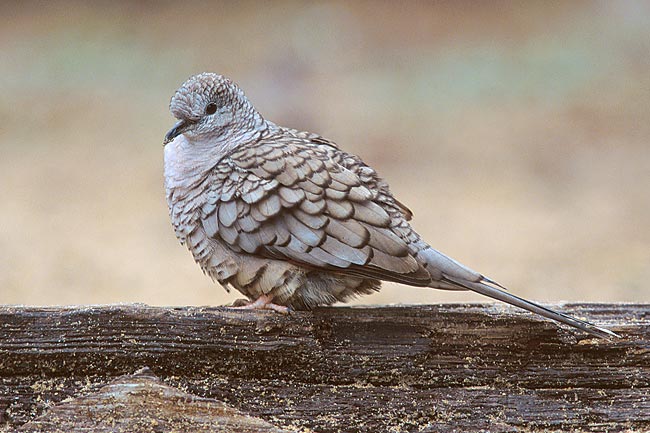
Scardafella inca
SUBFAMILY
Columbinae
TAXONOMY
Chamaepelia inca Lesson, 1847, Mexico. Monotypic.
OTHER COMMON NAMES
French: Colombe inca; German: Aztekentдubchen; Spanish:
Tortolita Mexicana.
PHYSICAL CHARACTERISTICS
Very small; 8 in (20 cm), 1.4 oz (40 g). Plumage appears scaly.
Every grayish brown feather is subterminally margined with
black.
DISTRIBUTION
From southern United States to Costa Rica.
HABITAT
Dry and open areas.
BEHAVIOR
Upon trespass by an intruder, the territorial male utters a guttural
call of great complexity and takes a horizontal posture in
which the tail is vertically raised and partly fanned. Because females
look like males, the territorial male always challenges an
intruding female. Courtship begins with the male bobbing his
head at the female and attempting to take her neck feathers in
his bill (heteropreening or billing). If the female is receptive
she will bob in return and follow the male’s lead in heteropreening.
The incipient pair may remain together for a week
or more before undertaking the next stages.
During cold weather, to conserve heat at night, they sometimes
form pyramids of five to 12 birds in two to three rows,
roosting on each other’s backs. May be become hypothermic,
body temperature drops 9–22°F (5–12°C) below normal.
FEEDING ECOLOGY AND DIET
Forage on the ground for seeds and small berries.
REPRODUCTIVE BIOLOGY
The precopulatory ritual is a capsule summary of the ritual in
pair formation, but takes 15–20 minutes rather than two weeks
or so. Males bob and preen and females respond; males go into
the bow-coo, standing horizontally with tail raised and widely
fanned and giving a call of moderate complexity. Females ultimately
beg for ritual feeding. Males feed females, then females
stand horizontally with wings slightly raised; males then
mount, and copulation occurs. Copulation almost never occurs
in pigeons and doves without the courtship feeding first being
given. Clutch of two eggs. Incubation for 14 days. Nestlings
brooded for eight days, fledging in 14 days; two days after
fledging, renesting may start.
CONSERVATION STATUS
Not threatened.
SIGNIFICANCE TO HUMANS
None known.
Other popular Animals
Photo Gallery of - Inca dove




 Animalia Life
Animalia Life